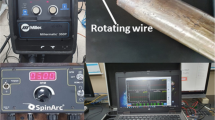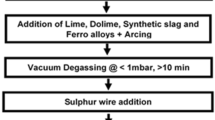Abstract
In an effort to determine the dissolution rate of the steel sheathing used in the production of cored wire, several experiments were conducted in the ASK Chemicals Metals Application Lab (MAL), in Dublin, Ohio. It is essential to understand that, when exposed to molten metal at a certain temperature/time, the low-carbon steel will dissolve, thereby exposing the contained alloy to the molten metal. This article presents two separate experiments that will provide a better understanding of the dissolution rates of the steel sheathing used in the 9-mm cored wire. The first experiment was an immersion test, where the finished product (cored wire containing a ferroalloy) was submerged in molten metal for a predetermined amount of time. The length of the cored wire was measured before and after the immersion to gauge the effect of time and temperature on the dissolution characteristics. The second experiment was conducted to examine the time and temperature needed to melt through a flat piece of metal sheathing. For this experiment, a flat piece of metal sheathing was placed over the down sprue of a sand-based pouring box. The basin was filled with molten metal at a predetermined temperature, and a high-speed camera and high-temperature thermocouples were used to record the temperature and the time needed to dissolve the metal sheathing.








Similar content being viewed by others
References
P. Cabanne, Magnesium Cored Wire Advantages and Disadvantages Vis a Vis Other Processes (Sorel Metal Website, 2006), http://www.sorelmetal.com/en/publi/PDF/109_(2006).pdf. Accessed 12 Jan 2017.
S.A. Argyropoulos, Electr. Furn. Proc. 41, 81 (1983).
Cleveland Electric Laboratories, Product Catalog: Thermocouples (Cleveland Electric Labs Website, 2017), http://www.clevelandelectriclabs.com/wpcontent/uploads/2017/01/ClevelandElectricLabsCatalog.pdf. Accessed 7 July 2017.
Acknowledgements
Special thanks to the ASK Chemicals Technical Center in Dublin, Ohio, for all their assistance and to Mark Adamovits for his direction on the concept of the melt-through test. Additional thanks to James Archibald for supporting this endeavor.
Author information
Authors and Affiliations
Corresponding author
Electronic supplementary material
Below is the link to the electronic supplementary material.
Rights and permissions
About this article
Cite this article
Rivera-Martínez, E.A., Beers, M., Scheller, E. et al. Dissolution Rate of Steel Sheathing Through Plunging and Melt-Through Methods. JOM 69, 1779–1784 (2017). https://doi.org/10.1007/s11837-017-2510-8
Received:
Accepted:
Published:
Issue Date:
DOI: https://doi.org/10.1007/s11837-017-2510-8




